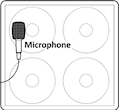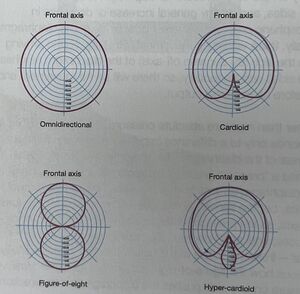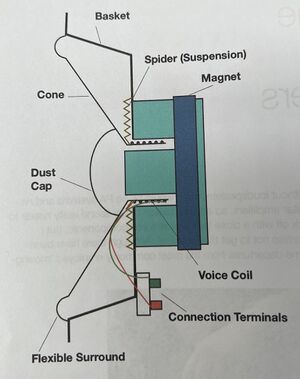This is the wiki for products made by Fractal Audio Systems, maintained by members of the community.
November 2025: the entire wiki has been updated with information about the new AM4 amp modeler.
Speakers and microphones
Contents
Microphones

Impulse responses are captured using microphones and mic preamps.
FRACTAL AUDIO QUOTES
[1] Using a "neutral" IR with a simulated mic does not sound the same as an IR using that mic. It simply can't. Neutral mics like the Earthworks TC series are nearly omnidirectional. They operate by using a very small aperture as compared to traditional mics that have effective apertures orders of magnitude bigger.
[2] The mic I've been most impressed with for recording guitar lately is the Beyer M160. I don't like SM57's alone for amps. They're too spikey and compressed but mixed with an M160 or R121 they add some nice sizzle.
[3] The M160 is an awesome guitar cab mic. All the IRs we got with the M160 came out really nice.
[4] My typical workflow is to choose an R121 or M160 first as these have the best low end. Then I choose an IR from one of the other mic types to get the desired brilliance. This is usually an SM57 or 4047. I just don't like 906s or 414s but that's me. I leave the panning at default but that's just my preference.
[5] If you get a chance try a Shure KSM313, an AEA R84 and a Beyer M160. The KSM313 is now my preferred mic for guitar cabs. I like it better than the R121. I find the KSM313 a little more balanced. The R121 has a lot of bass and proximity effect and the high end can be a little dull.
[6] My favorite mic for guitar cabs is the KSM313.
Certain mics like the royer 121 have 2 sides (front, back). Each has a different sound. Back side of the R121 is a bit darker. The difference between the front in the back is only apparent at closer mic distances. Get out past 3 feet and the sound the same on either side.
[7] The M160 is a good mic but there are better ribbon mics. My personal favorite is the KSM313. It's more balanced and has better high frequency response. I haven't tried the KSM353 yet but I imagine it's even better.
[8] IMHO nothing beats a KSM313 for "neutral" close mic'd IRs.
RedWirez' Dialing in Your Tone with RedWirez IRs
provides useful info about mics and mic positioning.
Wikipedia has articles about various microphones:
For additional information about microphones see these pages:
- Sound & Recording:
Mikrofonvergleich vor dem E-Gitarrenverstärker (Microphone comparison in front of the electric guitar amplifier)
- Wikipedia's
Microphone
article - Sound Schematic's
Microphones: Dynamic vs Ribbon vs Condensor
- Barry Rudolph's
Studio Microphone Techniques - How To Get A Great Electric Guitar Sound!
- Gearspace.com's
Mic Standards!
discussion - S. O. Coutant's articles:
- Sound On Sound's
Beyer M160
, Beyer M160 - Guitar World's
How to choose the best microphone for your electric guitar amp
From the book The SOS Guide to Live Sound
by Paul White:
Guitar speakers

Impulse responses reproduce the sound of a speaker in a cabinet. Here's background information on guitar speakers:
- Premier Guitar's:
- Legendary Tones'
Celestion Heritage Series G12M and G12H “Greenbacks”
- Sound On Sound's
Choosing Guitar-amp Speakers
andUnderstanding & Recording Guitar Speakers
- Eminence's
Tone Guide - Guitar Speaker Tonal Characteristics and Application Guide
- Fenderguru's
How to select speakers
- Bygone Tones'
Vintage Celestion Greenback Models
,Pre-Rola Greenbacks Explained, Part 1
andPre-Rola Greenbacks Explained, Part 2
- Celestion Speaker's
Celestion Speakers
, which are sound clips of Celestion speakers on SoundCloud - EVM-12L and EVM-12S reviewed
Jensen speakers:
P12R: 12” 15W
P12Q: 12” 20W
P12N: 12” 30W
P10R: 12” 15W
FRACTAL AUDIO QUOTES
[9] Break-in is definitely real with guitar speakers. The surround is stiff when new due to the doping. I don’t think monitors and hifi speakers exhibit any significant break-in.
[10] We witnessed speaker break-in first-hand when shooting IRs. We bought a brand-new 5150 III cabinet. Went to shoot some IRs and they sounded terrible. So I put the synth block on and ran the speaker for several hours while we were doing other stuff. Came back and shot some IRs and they were much better sounding.
[11] I've done quite extensive measurements and speakers aren't terribly nonlinear. They are somewhat nonlinear, especially at very high volumes but the nonlinearities they DO exhibit aren't particularly musical anyways. What they do exhibit is thermal compression and a "profile" won't capture that anyway for a couple reasons:
- The time constant is far too long for the neural net.
- The thermal compression causes the real part of the speaker impedance to increase. This interacts with the output impedance of the amplifier. This is modeled in our products. Our power amp modeling models the increase in impedance due to thermal compression. You can adjust this using, unsurprisingly, the Speaker Compression parameter. This wouldn't be captured accurately with a profile for reasons I'm not at liberty to divulge.
A speaker works because electricity runs through the voice coil wire, creating an electomagnetic polarity that shifts depending on the input signal. This makes the coil move closer to or away fom the magnet.
Ohm = AC Resistance, not AC current = impedance. Adding speakers in series increases resistance, adding speakers in parallel decreases resistance.
For example, two identical speakers wired in:
- Parallel: The combined impedance is half that of the individual speaker (2 x 8 ohm = 4 ohm).
- Series: The combined impedance is doubled (2 x 8 ohm = 16 ohm).
From the book The SOS Guide to Live Sound
by Paul White:
DynaCabs
Fractal Audio's DynaCabs (Axe-Fx III, FM9, FM3) let you pick a microphone and a cabinet, and visually position the mic where you want it to be. This will load the appropriate IR under the hood.

